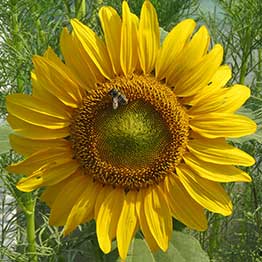Apr. 17 column: Attracting pollinators

This year, I’m all about attracting pollinators to my garden. And I’m hoping that’s on your to-do list as well.
In my column today, I discuss why this is more important than ever. I also talk about the different types of pollinators that you want to attract and it’s not just bees! Other critters that serve as pollinators include butterflies, hummingbirds, wasps, bats, flower flies and hover flies, and beetles. Amazing, isn’t it?
I also include suggested plants to attract these guys. You’ll notice there’s some overlap — certain plants’ flowers will draw in several different types of pollinators so you really get a lot of bang for your buck.
Here’s a link to my column in today’s edition of The Spokesman-Review: Plant garden to attract pollinators. (you can also read it below) I hope it will inspire you to attract as many pollinators to your garden as possible. You, your garden and the earth will benefit from it!
Attracting Pollinators garden column:
by Susan Mulvihill
As news of pollinator decline becomes more frequent, it’s clear that attracting pollinators to our gardens is more important than ever.
Pollinators help increase the production in our vegetable gardens, berry patches and orchards. In addition, flower pollination helps plants produce seeds. If there are no seeds, there will not be plants. That’s a pretty scary thought. And in turn, pollinators need both pollen and nectar in order to reproduce. So flowers and pollinators are completely reliant upon each other.
Causes of pollinator decline
There are many reasons for pollinator decline including habitat loss from property development as well as climate change, which has affected when plants bloom. Another cause is the use of pesticides. Research has shown that sprays containing neonicotinoids can affect a honeybee’s ability to fly, find pollen and make its way back to the hive.
It’s easy to think of honeybees as the only pollinators in our gardens, but it goes beyond that. There are over 4,000 species of native bees in North America. Most are solitary but some form small colonies. Examples of solitary bees include bumblebees, carpenter bees, leafcutter bees and mason bees. Other types of pollinators are butterflies, moths, hummingbirds, wasps, beetles and flower flies. Bats, birds and humans help out, too.
Tips for attracting pollinators
The best way to attract pollinators to your garden is to plant a diverse landscape. This includes layers of plants of differing heights such as annuals, perennials, shrubs, small understory trees and tall trees. These layers accommodate the different life cycle stages of each pollinator.
There are all sorts of wonderful plants that will attract bees. Bulbs such as allium, crocus and grape hyacinth are ideal, as are annual flowers like sweet alyssum, calendula, cosmos, sunflower and zinnia.
Last summer, I grew several different cultivars of sunflowers and was astounded by how many types of solitary bees were drawn to them. You can bet sunflowers will play an important role in this year’s garden.
Bees are also attracted to flowering herb plants and perennials such as goldenrod, Joe Pye weed, purple coneflower and sedum. Examples of flowering native shrubs include ninebark, ocean spray, snowberry, serviceberry and Oregon grape.
Tips for attracting butterflies
To attract butterflies, you’ll want to plant both host plants for their larvae and nectar plants for the adults. Host plants include members of the carrot family — dill, fennel and parsley, for example — and aster, milkweed and hollyhock. Annuals and perennials that supply nectar include cosmos, lantana, bee balm, phlox and yarrow. Honeysuckle and trumpet vines make attractive additions to the garden, and shrubs such as bluebeard, lilac, potentilla and spirea will draw in the butterflies.
Primarily nocturnal, moths are drawn to pale flowers since they can spot them in the moonlight. They also prefer fragrant blossoms.
Hummingbirds are attracted to red, orange and white flowers. Since bees can’t see the color red, butterflies and these amazing birds make sure red flowers are pollinated. Hummingbirds are particularly attracted to tubular flowers including nasturtium, salvia, bee balm, foxglove, lupine and penstemon.
While we gardeners are often fearful of wasps, they do play a valuable role in pollinating the flowers around us as well as controlling some insects. Both wasps and beetles are attracted to aster, black-eyed Susan, goldenrod, gooseneck loosestrife and yarrow. The most important thing is to avoid the use of pesticides. Instead, let the beneficial insects in your garden do the work for you or hand-pick damaging insects. If you must use a spray, choose an organic one and remember these rules: spray late in the day, when it’s calm and when flowers aren’t blooming.

